1.pandas介绍
1.1.简介
- 2008年WesMcKinney开发出的库
- 专门用于数据挖掘的开源python库
- 以Numpy为基础,借力Numpy模块在计算方面性能高的优势
- 基于matplotlib,能够简便的画图
- 独特的数据结构
1.2.优势
- 增强图表可读性
- 强大的数据处理能力(如处理缺失值)
- 读取文件方便
- 集成了matplotlib和numpy
2.数据结构
2.1.Series
Series由一对对index,value组成,类似于map和mongodb。
2.1.1.Series的创建
首先引入库
import pandas as pd
import numpy as np
创建Series的api是pd.Series(data=None, index=None, dtype=None)
data是数据,index是索引,dtype是数据类型
- 指定内容,默认索引
pd.Series(np.random.randint(-10,10,5))
0 3
1 9
2 4
3 -6
4 -9
dtype: int32
- 指定内容,指定索引
pd.Series(np.random.randint(-10,10,5),np.arange(5)+1)
1 1
2 8
3 0
4 7
5 -8
dtype: int32
- 通过字典数据创建
color_count = pd.Series({'red':100, 'blue':200, 'green': 500, 'yellow':1000})
color_count
red 100
blue 200
green 500
yellow 1000
dtype: int64
2.1.2.Series的属性
- index
color_count.index
Index(['red', 'blue', 'green', 'yellow'], dtype='object')
- values
color_count.values
array([ 100, 200, 500, 1000], dtype=int64)
- 下标值
color_count[0]
100
color_count[1]
200
2.2.DataFrame
DataFrame有两个索引,行索引和列索引,类似于excel
- 行索引,index,axis=0
- 列索引,columns,axis=1
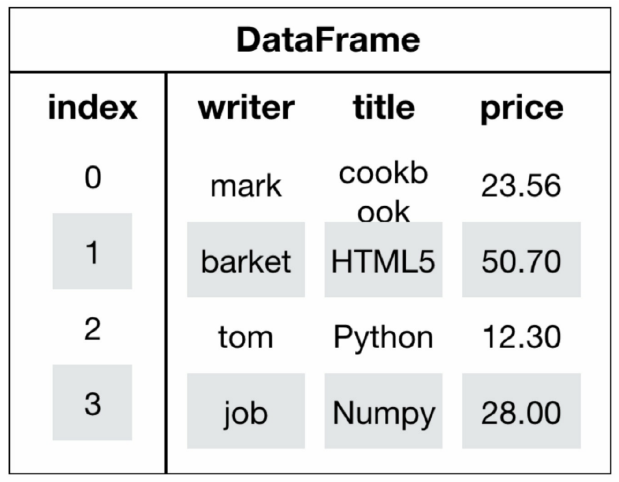
2.2.1.DataFrame的创建
使用api pd.DataFrame(data=None, index=None, columns=None)
下面是一个构建多个学生多科成绩的DataFrame构建过程:
# 随机生成十名同学的五科成绩
score = np.random.randint(60,100,[10,5])
# 利用二维数组构建DataFrame
score_df = pd.DataFrame(score)
score_df
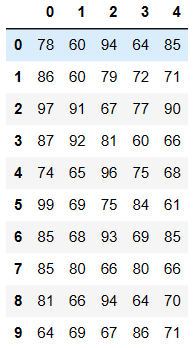
更改index和values
# 构造行索引序列
subjects = ["语文", "数学", "英语", "政治", "体育"]
# 构造列索引序列
stu = ['同学' + str(i) for i in range(score_df.shape[0])]
# 添加行索引
data = pd.DataFrame(score, columns=subjects, index=stu)
data
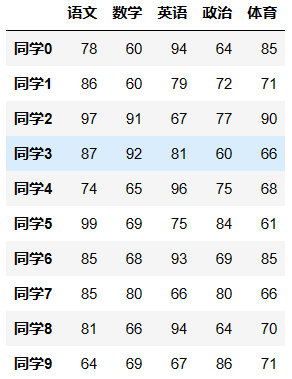
2.2.2.DataFrame的属性
- shape
data.shape
(10, 5)
- index
data.index
Index(['同学0', '同学1', '同学2', '同学3', '同学4', '同学5', '同学6', '同学7', '同学8', '同学9'], dtype='object')
- columns
data.columns
Index(['语文', '数学', '英语', '政治', '体育'], dtype='object')
- values
data.values
array([[78, 60, 94, 64, 85],
[86, 60, 79, 72, 71],
[97, 91, 67, 77, 90],
[87, 92, 81, 60, 66],
[74, 65, 96, 75, 68],
[99, 69, 75, 84, 61],
[85, 68, 93, 69, 85],
[85, 80, 66, 80, 66],
[81, 66, 94, 64, 70],
[64, 69, 67, 86, 71]])
- T
data.T
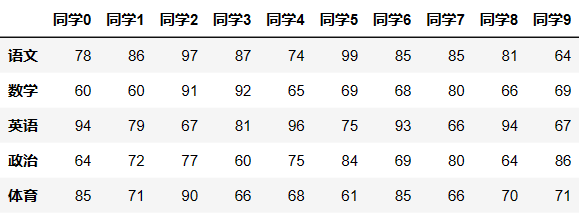
- head()
# default=5
data.head(5)
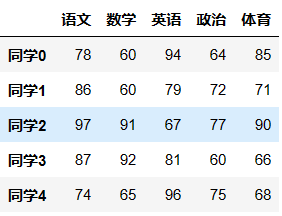
- tail()
# default=5
data.tail(5)

2.2.2.DataFrame索引的设置
2.2.2.1.修改行列索引值
stu = ["学生_" + str(i) for i in range(score_df.shape[0])]
data.index = stu
data
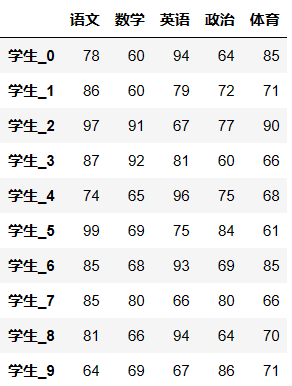
2.2.2.2.重设索引
# data本身不会改变,data的index还是学生_i的形式
# drop默认是False,即不会删除当前的index,同时还原之前的index。
# drop=True则会删除当前index,还原之前的index
data2 = data.reset_index(drop=True)
data2
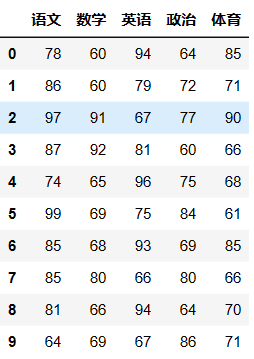
2.2.2.3.以某列为新的索引
df = pd.DataFrame({'month': [1, 4, 7, 10],
'year': [2012, 2013, 2012, 2014],
'sale':[55, 40, 84, 31]})
df
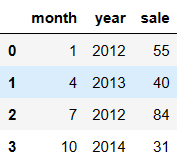
df.set_index("year")
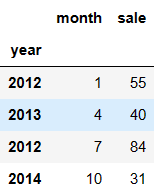
意义不明,后续用到了再回来补充
2.3.MultiIndex
3.基本数据操作
读取文件api,pd.read_csv("路径名")
读取股票数据
import pandas as pd
data = pd.read_csv("./data/stock_day.csv")
# 删掉六列
data = data.drop(["ma5","ma10","ma20","v_ma5","v_ma10","v_ma20"],axis=1)
data.head()

3.1.索引操作
3.1.1.直接使用行列索引
# 直接使用行列索引名字的方式(先列后行)
data['open']['2018-02-27']
23.53
# 不支持的操作
# 错误
data['2018-02-27']['open']
# 错误
data[:1, :2]
3.1.2.结合loc或者iloc使用索引
loc:使用行列索引名
data.loc['2018-02-27':'2018-02-22', 'open']
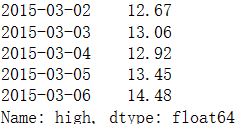
iloc:使用行列索引下标
# 获取前3天数据,前5列的结果
data.iloc[:3, :5]
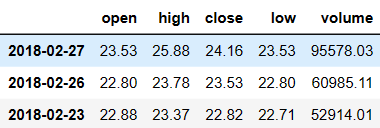
3.2.赋值操作
直接使用类似对象.属性的方式只能修改某列的数据
# 直接修改原来的值
data['close'] = 1
# 或者
data.close = 1
想要修改某行或者某区域的值得结合loc或者iloc
3.3.排序
3.3.1.DataFrame排序
- 单键排序
# 按open的值从小到大排列
data.sort_values(by="open", ascending=True).head()
- 多键排序
# 按open的值从小到大排列,如果相等,再排high
data.sort_values(by=['open', 'high'])
- 索引排序
# 按索引从小到大排列,默认是升序,即ascending=True
data.head().sort_index(ascending=False)

3.3.2.Series排序
Series的排序和DataFrame基本相同
- 按values排序
data['p_change'].sort_values(ascending=True).head()
- 按index排序
data['p_change'].sort_index().head()
4.DataFrame运算
4.1.算数运算
# open列每个值加1
data['open'].add(1)
4.2.逻辑运算
(data["open"] > 23).head()
# 2018-02-27 True
# 2018-02-26 False
# 2018-02-23 False
# 2018-02-22 False
# 2018-02-14 False
上面只能得到一个Series,利用该Series可以进行筛选:
data[data["open"] > 23].head()

多条件:
data[(data["open"] > 23) & (data["open"] < 24)].head()
query方法可以更好地实现上述功能且增加可读性:
data.query("open<24 & open>23").head()
特定值筛选:(类似于MySQL里的isin)
data[data["open"].isin([23.53, 23.85])]
4.3.统计运算
- describe(),得到各列值的统计结果
data.describe()
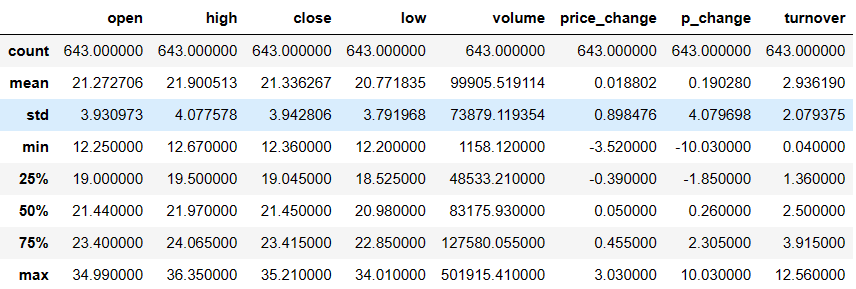
- max(),min(),最大值最小值
data.max()
# open 34.99
# high 36.35
# close 35.21
# low 34.01
# volume 501915.41
# price_change 3.03
# p_change 10.03
# turnover 12.56
# dtype: float64
- var(),std(),方差,标准差
data.var()
# open 1.545255e+01
# high 1.662665e+01
# close 1.554572e+01
# low 1.437902e+01
# volume 5.458124e+09
# price_change 8.072595e-01
# p_change 1.664394e+01
# turnover 4.323800e+00
# dtype: float64
data.std()
# open 3.930973
# high 4.077578
# close 3.942806
# low 3.791968
# volume 73879.119354
# price_change 0.898476
# p_change 4.079698
# turnover 2.079375
# dtype: float64
- median(),中位数
data.median()
# open 21.44
# high 21.97
# close 21.45
# low 20.98
# volume 83175.93
# price_change 0.05
# p_change 0.26
# turnover 2.50
# dtype: float64
- idxmax(),idxmin(),求最大值最小值所在行的index
data.idxmax()
# open 2015-06-15
# high 2015-06-10
# close 2015-06-12
# low 2015-06-12
# volume 2017-10-26
# price_change 2015-06-09
# p_change 2015-08-28
# turnover 2017-10-26
# dtype: object
- cumsum(累计和)
# 按照日期从小到大排列
data = data.sort_index()
stock_rise = data['p_change']
# 自身并不改变
stock_rise.cumsum()
# 2015-03-02 2.62
# 2015-03-03 4.06
# 2015-03-04 5.63
# 2015-03-05 7.65
# 2015-03-06 16.16
...
# 2018-02-14 112.59
# 2018-02-22 114.23
# 2018-02-23 116.65
# 2018-02-26 119.67
# 2018-02-27 122.35
# Name: p_change, Length: 643, dtype: float64
使用matplotlib显式地展现变化
import matplotlib.pyplot as plt
# plot显示图形
stock_rise.cumsum().plot()
# 需要调用show,才能显示出结果
plt.show()
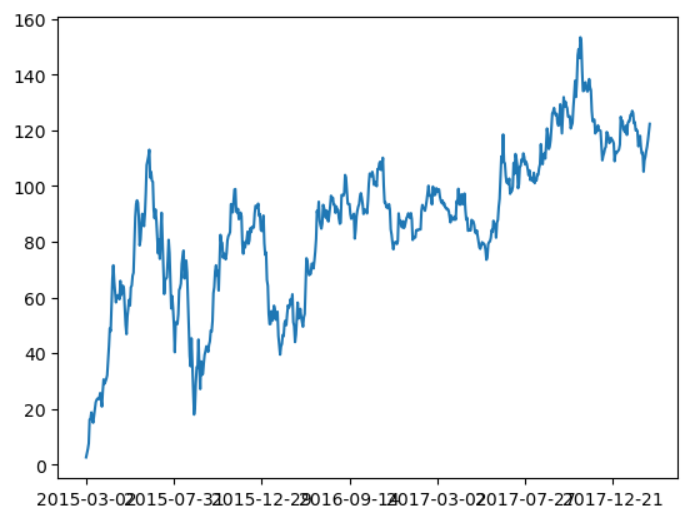
- cummax(目前为止的最大值)
- cummin(目前为止的最小值)
- cumprod(累积积)
4.4.自定义运算
api:df.apply(func, axis=0)
其中func是函数,axis是方向,0是列方向,1是行方向,默认是0
例子:
# 分别求open和close列中最大值与最小值的差距
data[['open', 'close']].apply(lambda x: x.max() - x.min())
# open 22.74
# close 22.85
# dtype: float64
5.Pandas画图
api是DataFrame.plot.barh(x=None, y=None, **kwargs)
具体的使用方法pandas官网文档有非常详细的说明
http://pandas.pydata.org/pandas-docs/stable/reference/api/pandas.DataFrame.plot.html
https://pandas.pydata.org/pandas-docs/stable/reference/api/pandas.Series.plot.html





















 2254
2254

 被折叠的 条评论
为什么被折叠?
被折叠的 条评论
为什么被折叠?








